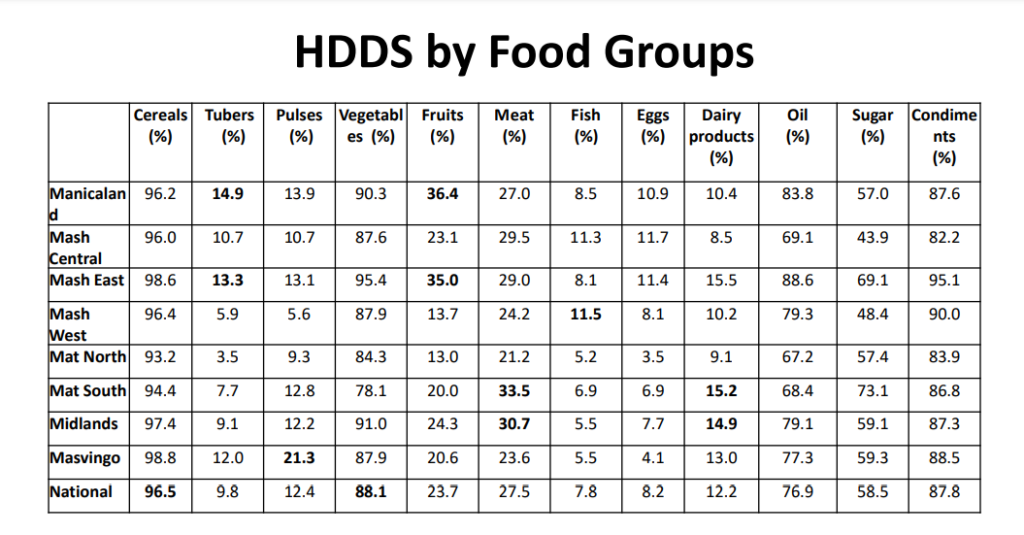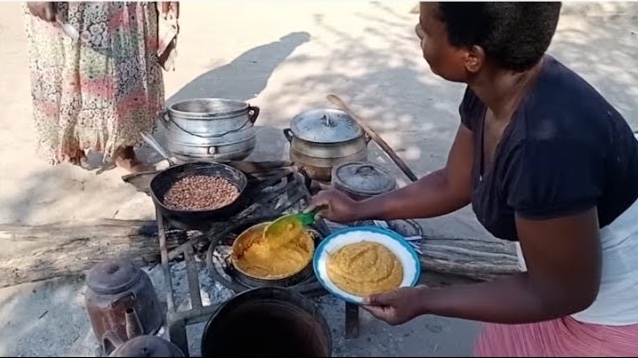The 2024 Zimbabwe Livelihoods Assessment Committee (ZimLAC) Rural Livelihoods Assessment Report has revealed significant shifts in food consumption patterns across rural Zimbabwe, with troubling implications for food security and nutrition.
Conducted by ZimLAC which is chaired by the Food and Nutrition Council, the report noted a decrease in acceptable food consumption from 70 percent in 2023 to 50 percent in 2024, while the proportion of households consuming poor diets increased from 5 percent in 2023 to 10 percent.
“The proportion of households with poor food consumption increased in most districts in 2024 compared to 2023. Gutu and Mbire (39 percent), Kariba (36 percent), and Rushinga (35 percent) had the highest proportion of households with poor food consumption patterns, while Chirumhanzu (zero percent) and Marondera, Mazowe, and Seke (one percent) had the least,” read the ZimLAC report.
The report indicates a marked decline in the consumption of traditional staple foods such as maize and small grains, accompanied by an increased reliance on less nutritious, cheaper alternatives.
“Similar to 2023, the most frequently consumed foods were cereals, vegetables, and oil, while milk and dairy products and pulses were the least consumed food groups,” read the report, which attributed the shift to a combination of factors including adverse weather conditions, economic challenges, and changing agricultural practices.

“Nationally, there was a decrease in the dietary diversity score from 5.6 in 2023 to 5.1 in 2024. All provinces saw a decrease in the dietary diversity score.”
The report showed that cereals (96.5%) and vegetables (88.1%) were the most consumed food groups across the country.
“Meat consumption was highest in the Midlands (33.5%) and Matabeleland South (30.7%) provinces. Mashonaland East (35%) and Manicaland (36.4%) had the highest consumption of fruits.”
The changing food consumption patterns are due to prolonged mid-season dry spells where the 2023/2024 El Niño-induced drought has severely impacted crop yields, particularly for maize and small grains, leading to reduced availability of these staples.
Nketha Mangoye-Dlamini, a farmer in Bulilima South, Matabeleland South, lamented that households have struggled with inconsistent rainfall patterns, resulting in poor harvests and a subsequent decrease in food supply.
“Changes in agricultural practices, driven by the need for drought-resistant crops, have also contributed to the shift in food consumption patterns. While crops like sorghum and millet are more resilient, their adoption has not been widespread enough to offset the decline in maize production,” he said.
Mangoye-Dlamini said that due to economic hardships, rising food prices have made it difficult for rural households to afford nutritious food.
“This is why many families are turning to cheaper, less nutritious options to stretch their limited incomes,” he said.
Critical studies scholar, Dr. Khanyile Mlotshwa, concurred that the shift in food consumption patterns has serious implications for the nutritional status of rural communities, particularly children.
“The reliance on less nutritious food options is leading to deficiencies in essential vitamins and minerals, exacerbating health issues. Enhancing food security programs, such as school feeding, can provide some relief for the vulnerable to access nutritious food,” he said.
“Social workers can also embark on nutritional educational campaigns to raise awareness about the importance of a balanced diet and the benefits of traditional foods. These campaigns need to be supported and budgeted for to encourage healthier meals and the farming of nutritious crops.”
Dr Mlotshwa added that households also needed support to beef up their food stocks.
“We have heard the government talk about cash transfers in urban areas while in rural areas it provides food. In the future, resources permitting, let’s focus on providing more diverse and nutritious diets when we give out food to fill the nutrition gap,” he said.
The ZimLAC report comes at a time when the majority of rural households in Zimbabwe rely on rain-fed agriculture, which is susceptible to climate change and variability. Dry conditions have adversely affected the commencement of planting nationwide, resulting in a substantial decrease in the area planted and crop yields.
ZimLAC said that in addition, the dry conditions resulted in low livestock productivity and poor pastures, which ultimately affect food security and livelihood options. The delayed onset of the rainfall season resulted in late planting, as most farmers started planting in late December following significant rainfall across the country, which also caused a trail of destruction to infrastructure and livelihoods.
ZimLAC said more than 80 percent of the country received below-normal rainfall by the end of February 2024.
“Prolonged dry weather conditions were experienced again in November and the first half of December 2023. The country further experienced the driest month of February on record,” said the report.
ZimLAC, through multi-stakeholder consultations, developed an appropriate assessment design concept note and data collection tools informed by the assessment objectives.
The primary data collection tools used in the assessment were the Android-based structured household questionnaire, the community Focus Group Discussion (FGD) guide, the Irrigation Key Informant Interview, and the Chiefs’ FGD guide.
ZimLAC national supervisors (including Provincial Agritex Extension Officers and Provincial Nutritionists) and enumerators were recruited from government, United Nations, technical partners, and non-governmental organizations, and underwent training in all aspects of the assessment. Training for enumerators was done at the district level, coordinated by the Ministry of Local Government, which also mobilized provincial supervision and district enumeration vehicles.
Three enumerators were selected from each district for data collection, and one anthropometrist was responsible for taking anthropometric measurements. Primary data collection took place from May 4 to 20, 2024, while data analysis and report writing ran from May 27 to June 7, 2024.

